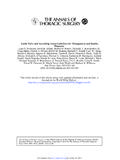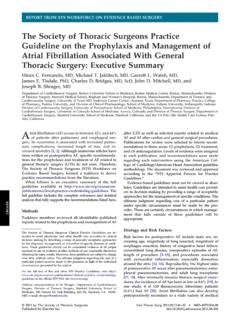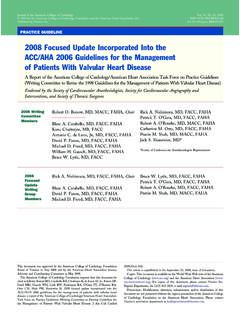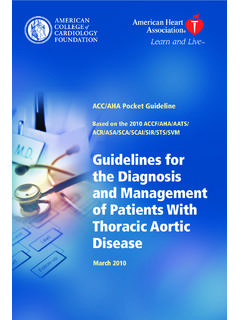Transcription of Aortic Valve and Ascending Aorta Guidelines for ... …
1 DOI: 2013;95:1-66 Ann Thorac SurgVinod H. Thourani, E. Murat Tuzcu, John Webb and Mathew R. Williams Michael Reardon, T. Brett Reece, G. Russell Reiss, Eric E. Roselli, Craig R. Smith, Kodali, Samir Kapadia, Martin B. Leon, Brian Lima, Bruce W. Lytle, Michael J. Mack,Dewey, Richard S. D'Agostino, Thomas G. Gleason, Katherine B. Harrington, Susheel Joseph E. Bavaria, Eugene H. Blackstone, Tirone E. David, Nimesh D. Desai, Todd Miller, Patrick T. O'Gara, David M. Shahian, Hartzell V. Schaff, Cary W. Akins, Lars G. Svensson, David H. Adams, Robert O. Bonow, Nicholas T. Kouchoukos, D. MeasuresAortic Valve and Ascending Aorta Guidelines for Management and Quality on the World Wide Web at: The online version of this article, along with updated information and services, isPrint ISSN: 0003-4975; eISSN: 1552-6259. Southern Thoracic Surgical Association. Copyright 2013 by The Society of Thoracic Surgeons. is the official journal of The Society of Thoracic Surgeons and theThe Annals of Thoracic Surgery by on May 28, 2013 from SPECIAL REPORTA ortic Valve and Ascending Aorta Guidelinesfor Management and Quality MeasuresWriting Committee Members: Lars G.
2 Svensson, MD, PhD (Chair),David H. Adams, MD (Vice-Chair), Robert O. Bonow, MD (Vice-Chair),Nicholas T. Kouchoukos, MD (Vice-Chair), D. Craig Miller, MD (Vice-Chair),Patrick T. O Gara, MD (Vice-Chair), David M. Shahian, MD (Vice-Chair),Hartzell V. Schaff, MD (Vice-Chair), Cary W. Akins, MD, Joseph E. Bavaria, MD,Eugene H. Blackstone, MD, Tirone E. David, MD, Nimesh D. Desai, MD, PhD,Todd M. Dewey, MD, Richard S. D Agostino, MD, Thomas G. Gleason, MD,Katherine B. Harrington, MD, Susheel Kodali, MD, Samir Kapadia, MD,Martin B. Leon, MD, Brian Lima, MD, Bruce W. Lytle, MD, Michael J. Mack, MD,Michael Reardon, MD, T. Brett Reece, MD, G. Russell Reiss, MD, Eric E. Roselli, MD,Craig R. Smith, MD, Vinod H. Thourani, MD, E. Murat Tuzcu, MD, John Webb, MD,and Mathew R. Williams, MDCleveland Clinic, Cleveland, Ohio; Mount Sinai Medical Center, New York, New York; Northwestern University Medical School,Chicago, Illinois; Cardiac, Thoracic and Vascular Surgery, Inc, St.
3 Louis, Missouri; Falk Cardiovascular Research Center, Palo Alto,California; Brigham and Women s Hospital, Boston, Massachusetts; Massachusetts General Hospital, Boston, Massachusetts; MayoClinic, Rochester, Minnesota; Hospital of the University of Pennsylvania, Philadelphia, Pennsylvania; Toronto General Hospital,Toronto, Ontario; Technology Institute, Dallas, Texas; Lahey Clinic Medical Center, Burlington, Massachusetts; University of PittsburghSchool of Medicine, Pittsburgh, Pennsylvania; Stanford University Medical Center, Stanford, California; New York PresbyterianHospital/Columbia University Medical Center, New York, New York; Columbia University Medical Center, New York, New York;Baylor Health Care System, Dallas, Texas; Methodist Hospital, Houston, Texas; University of Colorado, Boulder, Colorado; Dean HealthSystem, Madison, Wisconsin; Emory University School of Medicine, Atlanta, Georgia; and St. Paul s Hospital, Vancouver, BritishColumbia1.
4 Introduction and MethodologyThe question may be asked why another Guidelinemanuscript is needed. The reasons arefivefold: (1) tooutline pros and cons of treatment options; (2) to outlineareas where further research is needed, potentially fromupdated Society of Thoracic Surgeons (STS) data collec-tion variables as there are few randomized trials that givemore absolute answers to questions; (3) to provide tech-nical Guidelines for Aortic Valve and Aortic surgery; (4) toprovide background for recommended quality measuresand suggest quality measures; and (5) to present the newSTS Valve data collection variables that address issuesrelated to the preoperative testing and technical aspectsof Aortic Valve surgery (Appendix 1).The evaluation of Aortic Valve procedures suffers froma dearth of prospective randomized trials that haveshown definitive superiority of one procedure overothers, although this has been attempted (eg, mechanicalversus biological valves , and homografts versus Rossprocedure, etc)[2 18].
5 Indeed, when Valve devices arecompared for survival (homograft, biological valves ,mechanical valves or Ross procedure) and the onlyadjustment made is for age, there is no difference at all inlate survival and thus the debate revolves more aroundvalve durability and anticoagulation[14] (Figs 1 to 3).Hence, the Guidelines rely primarily on nonrandomizedtrials, observational studies, registries, propensity anal-yses, and consensus statements of experts. Clearly, thesemay require revision over time, particularly related to thenew transcatheter Aortic Valve replacement (TAVR)procedures. The application of class of recommendationand level of evidence characterization is according to thoserecommended by ACCF/AHA (Table 1).The Guidelines address only the adult population andnot the pediatric population. When needed, the guide-lines draw heavily from the previously published 2010 The Society of Thoracic Surgeons Clinical Practice Guidelines are inten-ded to assist physicians and other health care providers in clinical decisionmaking by describing a range of generally acceptable approaches for thediagnosis, management, or prevention of specific diseases or Guidelines should not be considered inclusive of all proper methodsof care or exclusive of other methods of care reasonably directed atobtaining the same results.
6 Moreover, these Guidelines are subject tochange over time, without notice. The ultimate judgment regarding thecare of a particular patient must be made by the physician in light of theindividual circumstances presented by the the full text of this and other STS Practice Guidelines , the official STS Web site ( ).Address correspondence to Dr Svensson, The Cleveland Clinic, 9500 Euclid Ave, Desk F-25 CT Surgery, Cleveland, OH authors disclosure of industry relationships, seeAppendix 2. 2013 by The Society of Thoracic SurgeonsAnn Thorac Surg 2013;95:S1 S66 0003-4975/$ by Elsevier by on May 28, 2013 from ACCF/AHA/AATS/ACR/ASA/SCA/SCAI/SIR/STS/S VMguideline for the diagnosis and management of patientswith thoracic Aortic disease. Hence, indications forsurgery are not covered in detail, except where newevidence suggests an update is needed. The previousguidelines for severity of disease and the managementof outcomes for patients with asymptomatic disease aresummarized and covered in detail in the 2010 docu-ment[1, 19, 20].
7 For cardiologists and cardiac surgeons,there have been few options and no Guidelines on howto manage the high risk, previously inoperable,patients. The TAVR technology and particularly thepivotal Placement of Aortic Transcatheter (PARTNER)trials and the ongoing CoreValve trial have furtherfocused efforts on managing this population. Previousstudies have suggested that between 38% of patients(Europe) and two thirds of patients (southern Cal-ifornia) with severe Aortic Valve stenosis go untreated[21, 22]. With the advent of TAVR both the traditionallyopen Aortic Valve replacement (AVR) procedures andballoon Aortic valvuloplasty (BAV) have also pari passuevolved. Hence, these aspects are discussed. Thefield israpidly developing, and undoubtedly later guidelineswill need to update recommendations based on searches were conducted using standard-ized MeSH terms from the National Library of MedicinePUBMED database list of search terms. Section authorsthen drafted their recommendations, using prior pub-lished Guidelines as a reference when available, andcirculated to the entire writing committee as were made until consensus was reached onclass, level of evidence, references, and , the full document was submitted for approvalby the STS Workforce on Evidence Based Surgerybefore publication.
8 The Guidelines were posted on theSTS website for an open comment period. The guide-lines then were also submitted to the STS Council onQuality, Research, and Patient Safety Operating Boardand the STS Executive Committee before submission Evaluation of a Valve ProcedureParamount to evaluating a Valve procedure is (1) easeof procedure; (2) safety; (3) efficacy (hemodynamicperformance, effective orifice area, and energy loss); (4)durability, measured as freedom from structural valvedeterioration; and (5) event-free Aortic valves this would entail (1) ease of prostheticaortic Valve insertion or Valve repair; (2) safety of theFig 1. Options for minimally invasive J and AcronymsABP = antegrade brain perfusionACE = angiotensin-converting enzymeAR= Aortic regurgitationAS= Aortic stenosisAVA = Aortic Valve areaAVR = Aortic Valve replacementBAV = balloon Aortic valvuloplastyBSA = body surface areaCABG = coronary artery bypass graftCAD = coronary artery diseaseCT= computed tomographyDLCO = diffusing capacity of lung for carbonmonoxideECG = electrocardiogramEF= ejection fractionEOA = effective orifice areaFDA = Food and Drug AdministrationHCA = hypothermic circulatory arrestIMH = intramural hematomaINR = international normalized ratioIVUS = intravascular ultrasoundLV= left ventricularMRI = magnetic resonance imagingPFT = pulmonary function testPPM = patient-prosthetic mismatchPROM = preoperative risk of mortalityRBP = retrograde brain perfusionRVOT = right ventricular outflow tractSVD = structural Valve deteriorationTAVR = transcatheter
9 Aortic Valve replacementTEE = transesophageal echocardiogramTTE = transthoracic echocardiogramS2 SPECIAL REPORTSVENSSON ET ALAnn Thorac SurgAORTIC Valve / Ascending Aorta MANAGEMENT & QUALITY MEASURES2013;95:S1 S66 by on May 28, 2013 from operation; (3) effective orifice area (EOA) includinggradients and energy loss; and (4) long-term durability,with no difference in survival compared with otherdevices, but better than the untreated , there are few, if any medical procedures that areas effective in relieving symptoms, improving quality of life,and also increasing long-term survival as much as AVR foraortic stenosis (AS) or Aortic regurgitation (AR), but forperhaps the exception of heart transplantation, but the latteradds the problem of managing new medications andincreased monitoring. Recent data from 3,600 Medicarepatients show that there is a reduced hospital readmissionrate and increased survival among high-risk Medicarepatients (aged 65 years) treated with AVR for severe AS,despite the extra cost.
10 Of note, open AVR does not reducethe cost when compared with medical management despitethe multiple readmissions for heart failure in the potential population needing AVR for severe AS isestimated at 350,000 and increasing. The exact number ofaortic Valve procedures, including repairs and replace-ments, is unknown. A number of 48,000 has been reported[23]; however, a number of 95,000 Medicare patients wasreported in a recent publication[24](Tables 2and3).Table 2shows the number of valves sold to hospitals forone year (92,514). The STS Adult Cardiac SurgeryDatabase (ACSD) does not capture the number as onlypatients who undergo single Valve or Valve plus coronarybypass are tracked. Double Valve , AVR plus Aorta , and soforth, are not tracked. Nevertheless, the STS data showAVR is increasing, probably because of the agingpopulation and increasing awareness of good results, andthe option of TAVR. Despite this, on average an STS sitedoes 23 isolated Aortic valves and on average a cardiacsurgeon only does 8 AVR per annum (Fig 4).











